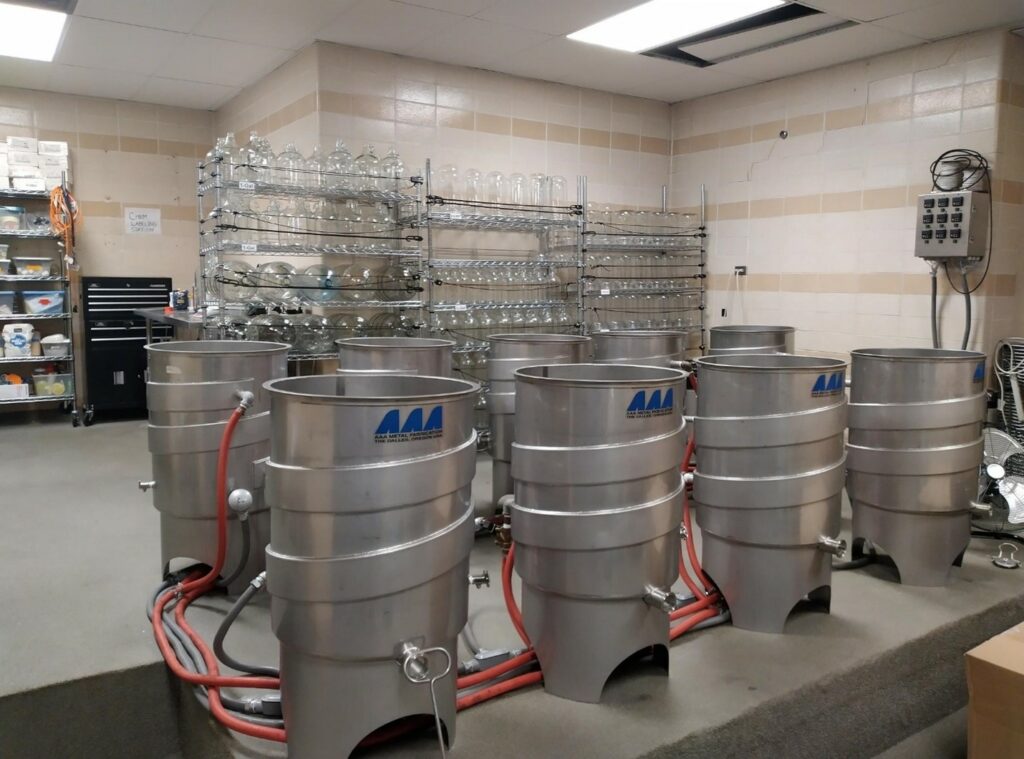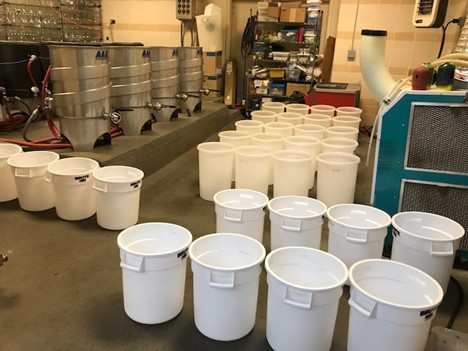James A. Sterns, Associate Professor, Applied Economics, OSU, jasterns@oregonstate.edu
With genuine concerns for the loss of life and property during this time of still-burning wildfires, I am also challenged by questions about the economic consequences of these fires for Oregon’s wine industry. With most grapes still in the vineyard, the potential for significant loss of this year’s harvest weighs heavily on vineyard managers throughout the state. The short-run answer, unfortunately, is frustratingly vague. It’s like I am trapped in an NPR radio broadcast of Michael Feldman’s comedy quiz show, Whad’Ya Know? Each episode begins with the show’s namesake and host asking his live audience that question, to which the audience replies in unison, “Not much!”
This article has two goals – first, summarize and provide links to the limited amount of information that is available; and second, to outline suggestions for creating the necessary records, data sets and documentation that will allow us to be better positioned to answer questions about the economic consequences of future smoke events.
First, what do we know? Several websites provide one-stop sourcing of available information. These include the Oregon Wine Board Wildfire Smoke Toolkit webpage and the University of California-Davis Wildfire and Smoke Exposure Resources website. Another comprehensive source of information is available from the Australian Wine Research Institute, which has been very active in recent years in supporting research on how smoke events can affect wine grapes and wine making.
These and other sources (reference links throughout this article) help frame questions about the overall consequences of smoke events. Still, in general, economic impacts are not addressed in any detailed manner. That type of substantive research-based information is still needed. As Associate Professor Elizabeth Tomasino and her colleagues reported in the August 2020 Vine to Wine issue, plans are in the works for grant-funded research on this topic. Their first step was to conduct a needs assessment with industry stakeholders, which included a shortlist of research topics related to smoke events’ economic impacts. As that research moves forward, one of the key constraints will be the availability of data from Pacific Northwest vineyards and wineries. Vineyard managers and wine makers can help resolve this ongoing challenge. Here are a few suggestions for how to help by documenting what is happening now and keeping records of this information for future reference.
Data needs for Estimating Economic Consequences in Vineyard and Wineries:
Weather & Air Quality Data – Keep track of your local smoke event data, which may be simple observational data (e.g., dates and duration of when you can smell smoke in your locality). Alternatively, some vineyards may have contracted with private farm management service providers, and in some instances, these providers have installed weather sensors. If this is the case, then the key is to archive in an easily accessible database detailed daily wind, temperature, humidity, and air quality readings as site- specific as possible. Understanding “trigger” levels of exposure that lead to smoke compounds in wines can become the basis for future vineyard management decision making. This starts with our ability to link vineyard conditions with test results of smoke contamination in wine crushes.
Variable, Fixed, and Total Costs – I often ask my students if it is ever a good idea to keep farming when losing money. I am trying to have them understand that a decision to go idle for a season or not harvest a crop will still have fixed costs to be paid. The choice to lose money is relative, so the better question a manager needs to ask is, “Which option will involve the least amount of loss?” In terms of this year’s grape harvest, can a vineyard manager hope to make enough from a harvested crop to cover all the variable costs associated with that harvest plus cover some of the fixed expenses that will always need to be paid? If so, then that’s the better choice. If the harvested crop’s value is less than the sum of variable costs of harvesting it, then obviously, it’s better not to harvest. In terms of data to be tracked, keeping detailed estimates of fixed and variable costs will not only help with decisions that must be made now, but also this financial information can be evaluated in a broader context for future smoke events. If enough vineyards track these costs, that data could be collected and aggregated anonymously, and then financial benchmarks could be established for making more informed decisions in years to come.
Dump, divert, or distill – A current recommendation for vineyard managers is to conduct small lot fermentations (a.k.a. micro-ferments or bucket-ferments) on grapes that have been exposed to smoke. Should results from these tests indicate that the grapes are unusable for wine, there are still managerial decisions to make. Once again, cost and price data are needed to inform this decision. Option one is to dump the grapes in the vineyard, either in the near future, or possibly waiting until pruning. Both options have vineyard management issues, but also economic ones. For example, what are the labor (and possibly machine costs if mechanically harvested) to dump the grapes now compared to potentially higher pruning labor time and costs if the grapes are left on the vine until then? Another possibility – grapes have nutritional value as animal feed. Could harvested grapes be sold to a neighboring livestock operation? And more importantly, what is the price the neighbor is willing to pay and is that price high enough to cover harvesting costs? A third option might be to use the grapes for distilling alcohol for the hand sanitizer market – a new market opportunity that has emerged during the COVID-19 pandemic. Again, the critical issue is the potential market value of the smoke-affected grapes for use as an input in this alternative product market.
Market responses, on inventory and current year crop – Another key area of data to track will be the market responses to these wildfire events. Two prices to track and record will be the value of any residual 2019 harvest in inventory, such as bulk wine. If this year’s smoke events leave wine makers shy on volume, will this lead to a price increase in the value of that inventory? If so, that is an economic consequence to document. Similarly, depending on the severity of this year’s smoke event, grapes grown in 2020 that are unaffected by smoke may see a price increase. Again, documenting any smoke-event driven shifts in prices will be critical for future work in estimating economic consequences.
Consumer responses, on-site and online – The COVID-19 pandemic complicates the analysis, but there still needs to be data collected about how winery customers are responding to the wildfires. On-site tasting room visits, which were already diminished by social distancing and other public health measures, will be further eroded by the wildfires. Collecting data on declines in visitations attributable to the wildfire will help future analyses. Similarly, tracking online sales, especially if consumers are shifting their buying habits, is also needed. Will consumers buy more of the current inventory in fear of future shortages? What are wine club members asking you during this time? Tracking their concerns and questions may be early indicators of how future sales of the 2020 vintage will be impacted. Aggregating these data, even if the overall effect on demand is negligible, will provide vital information for future analysis and forecasts of smoke events’ economic consequences.
Insurance Costs and Compensation – A final area of data that is needed concerns crop insurance. Data on insurance premiums paid by vineyards are needed. Even if a vineyard or winery opted not to purchase crop insurance, records of insurance companies’ quotes for proposed premiums are valuable for future analysis. Also needed are the costs of checking for potential, and if needed, proof of damage (e.g., costs of testing for smoke compounds and any other expenses of documenting the damage and certifying rejected sales). Finally, records about the amount of financial compensation received, should an insurance claim be paid will be important for future economic analysis. This should include any details about factors that affected the overall level of compensation (for example, some insurance policies will adjust claims and reduce the amount of payment if a vineyard is not harvested).
As we look to the future, we can anticipate a need for a better understanding of how wildfires and smoke events can affect the Oregon wine industry’s economic viability. Tracking and recording what is happening now, as decisions are being made in vineyards and wineries, will be vitally important sources of information for future research. With resiliency, the Oregon wine industry will emerge from the tragedies of this wildfire season. Let us work together to ensure that we can do better in the future by learning through our current adversities.














